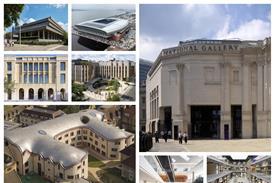Sebastian Hernandez of Stora Enso, joins architect Andrew Waugh, and Mario Lederman of Lendlease to discuss how the wooden building industry in the UK can start to think bigger

In July last year, the Environmental Audit Committee was the latest in a long line of voices for the UK (especially England) to indicate a desire to get serious about the potential of timber as a construction material that can help the country meet its decarbonisation targets. In fact, the value of the material has even been recognised in the government’s own Net Zero Strategy.
This would suggest a great deal of momentum for wooden buildings in the UK. However they remain a niche segment of the building stock, typically associated with small-to-medium size projects.
For timber – notably engineered mass timber – to deliver on its potential contribution to the country’s decarbonisation targets, it needs scale. That means more projects, and bigger projects to showcase exactly what the material is capable of.
Here, Sebastian Hernandez of renewable materials company and mass timber producer, Stora Enso, joins award-winning architect Andrew Waugh of Waugh Thistleton Architects, and Mario Lara Lederman of developer Lendlease to discuss how the wooden building industry in the UK can start to think bigger.
A big future for timber
Just what does the future look like for timber buildings in the UK – or at least, what could it look like?
Mario Lara Lederman (ML): “We’ve made good progress but there are still challenges to delivering more timber buildings in the UK, as there are in the rest of Europe. The future will depend on how we can collaborate to overcome those challenges.
“A good example of this in action is one of our biggest projects – the Milan Innovation District (MIND) – a 100 hectare new district incorporating office, residential, retail, research, university and public spaces. MIND is an example of something I think we’ll see more of in the future, which is hybrid design combining timber and elements incorporating traditional construction materials.
“Then, over time, as there is more performance data and familiarity with the material, we might shift back to pure timber”
“As you increase in project scale, you also go up against more regulations, more design challenges and have a much wider group of stakeholders to keep happy. That’s when an element using concrete or steel might be strategically deployed, such as concrete cores, to remove a risk – real or perceived – and keep everyone satisfied to keep the project moving forwards.
“Then, over time, as there is more performance data and familiarity with the material, we might shift back to pure timber - even for large scale projects.”
Andrew Waugh (AW): “Hybrid design may be an option for the immediate future, but it will very quickly become a luxury we can’t afford, even for large-scale projects. Let me be clear: this is not a choice. In ten years’ time, architects and developers can’t be saying to themselves: ‘should I do concrete or should I do timber?’ No – it must be all timber; the urgency of climate change demands nothing less.
“We need that level of momentum. And MIND is a good example of where that will come from: cities and municipal government. From Milan, to Berlin and Helsinki, city governments are showing climate leadership through tools like planning policy, and if we have another summer as calamitous as the last one in terms of heat, then I think that will accelerate.”
Sebastian Hernandez (SH): “That dual focus on urban development and climate change fits neatly with the capabilities of wooden buildings for large projects. For example, a trend we see is that large projects are tending towards more flexible design.
“Wood is excellent for that, allowing for far more adaptable design”
“In the past, since the 1950s, the paradigm was to optimise buildings to their specific use case, such as a hotel. Now, we see greater recognition (perhaps inspired by Covid) that a building’s use may flex and change over its lifetime, and that future proofs the development by reducing the need to tear things down and start again when the fabric of the city changes.
“Wood is excellent for that, allowing for far more adaptable design and, of course, greater circularity if and when change is required.”
Overcoming barriers
It makes sense then, that we may see a future in the UK where timber buildings are far more prevalent for small and large developments alike, driven by city government and the need to be adaptable to the changing nature of urban life. However, such a future is far from guaranteed.
ML: “Ultimately, the barriers for greater use of timber in large buildings are threefold: a code and regulation framework designed to support steel and concrete, a lack of familiarity with timber in the industry, and available data. Of course, you need supportive building codes and regulations – architects and developers aren’t going to use materials they’re unfamiliar with – and data reduces risk and unsticks decision-making in every sphere.
“Take insurance for example – many people think timber buildings are hard to insure and that’s a major barrier. But really that’s a data issue – give the insurers the data and they’ll soon become more comfortable.”
AW: “That’s exactly what’s happening. For example, we’re working with the Laudes Foundation to design a pre-warrantied wooden building system for heights of up to 18m, with taller projects to follow. There are 25 aspects pre-approved by both the building code authority and warranty provider, which makes it easier to get insurance and mortgages, and de-risks the project for everyone.
“The financial world isn’t the barrier”
“And, on the topic of the financial stakeholders, they can actually be major drivers for change. After all, the UK views itself as a financial hub, and one of the hottest topics in finance right now is ESG. Investors, insurers, lenders – they’re actively looking for new ways to provide financial services in line with sustainability criteria – and timber buildings fit the bill.
“Add to that the fact that timber buildings provide demonstrably better rents and yields – something very attractive against the current economic background – and you have a strong financial case for them. The financial world isn’t the barrier – in fact, I don’t know of a single timber building uninsured in the UK today.”
SH: “That work with the Laudes Foundation highlights the importance of collaboration here. If we’re to grow the use of timber in UK building stock, we need more collaboration than competition – both between stakeholders at the project level, and across the industry level.
“For example, the Structural Timber Association is working on fire testing and guidance, bringing together expertise from across the industry to provide that guidance and data that Mario referred to.”
AW: “That is important and it is improving. I remember when we did Murray Grove in 2007 – there must have been something like 15 different timber organisations pulling in different directions. Collaboration and consolidation has helped, but we need far more from the industry.”
SH: “Collaboration is also key on the project level – doubly so when we talk about large developments. Inefficiencies that are inconsequential on a small project can snowball and become major problems at scale.
“If a small issue causes you to lose half a day on single house build, that’s annoying. If the same issue loses you half a day at fifty points across a larger site and causes other delays, that can get expensive.
“Improving technology and offsite processes can also help eliminate some of these inefficiencies”
“Things like component standardisation and prefabrication therefore become far more important for larger sites, but they require collaboration to get value. For example, there’s no use completing a job in half the time if the delivery schedule means you’re sat waiting for the next trade before you progress. And standardisation only works if you have consensus.
“Improving technology and offsite processes can also help eliminate some of these inefficiencies. Look at moisture protection for example.
“For a small wooden building, you can usually get away with putting up tarpaulin, hoping it doesn’t rain and getting a couple of layers of coating applied on site – it’s easy to manage. A large project will have the structure open to the elements for several weeks and the same approach isn’t practical – you need to pre-apply the coatings offsite.
“We’ve seen first-hand what timber offers in terms of a quicker, cleaner build”
“The common theme here is that none of the barriers to a bigger future for wooden buildings are insurmountable, and collaboration across the supply chain is chipping away at a steady pace – though maybe not quite fast enough. We have to bear in mind though, the huge benefits these materials offer.
“We’ve seen first-hand what timber offers in terms of a quicker, cleaner build, a more beautiful, health-giving final building for occupants, and of course reduced embodied carbon. These are worthy things to aim for in new buildings.
“Plus, as Andrew said, the urgency of climate change means we cannot afford anything less than the highest ambitions.”
Also read >> In pictures: Waugh Thistleton’s timber office building opens in east London
Postscript
Sebastian Hernandez is R&D manager for Stora Enso; Andrew Waugh is a founder and director of Waugh Thistleton Architects; Mario Lara Ledermannis technical lead at Lendlease
















1 Readers' comment